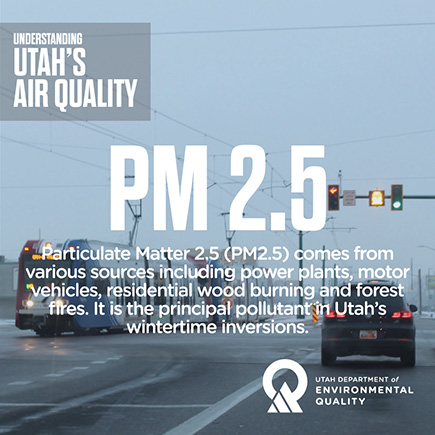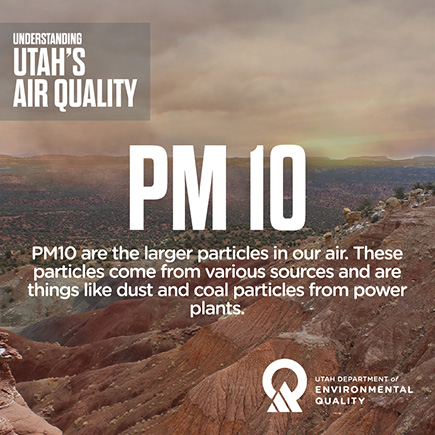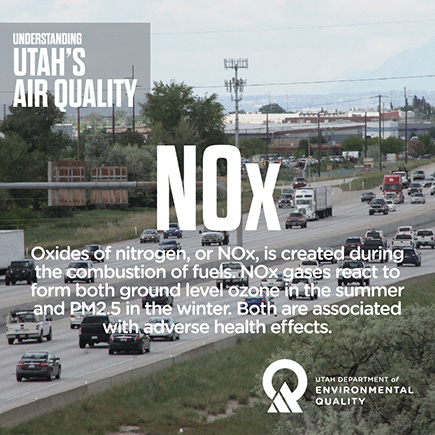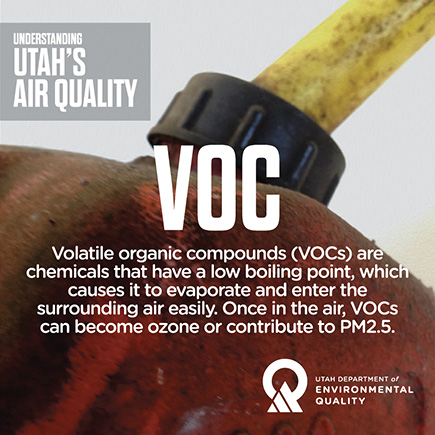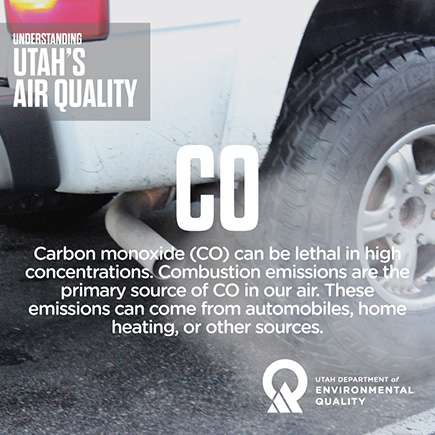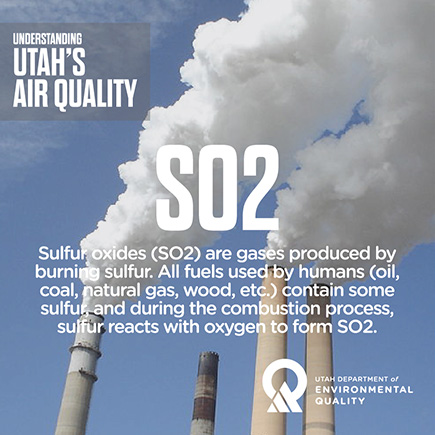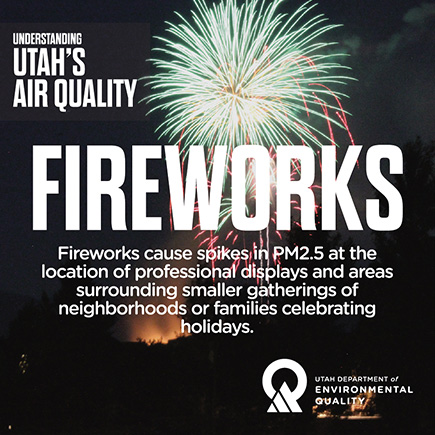Understanding Utah’s Air Quality
Here is a quick overview of the chemicals we look for when monitoring the air and the sources of these pollutants.
PM2.5
PM2.5 is the main component of Utah’s wintertime air pollution. PM2.5 refers to microscopic particles, or particulate matter (PM), that have a diameter of less than 2.5 micrometers—smaller than pollen and most bacteria.
During an inversion, temperatures increase with increasing altitude—the inverse of what normally happens. The warm inversion layer then acts as a cap and stops atmospheric mixing. This holds PM2.5 near the ground and causes the smog that occasionally covers the valleys of Northern Utah.
Sources of PM2.5 are broken down into three categories: point sources, mobile sources, and area sources. Point sources (13 percent of a typical inversion) are large stationary industrial or commercial facilities. Mobile sources (48 percent of a typical inversion) are non-stationary sources such as vehicles, trains and aircraft. Area sources (39 percent of a typical inversion) are smaller stationary sources. These include emissions from home heating, smoke from wood burning, and emissions from small businesses like restaurants and dry cleaners.
Ozone
Ozone is formed when oxides of nitrogen (NOx) and volatile organic compounds (VOC) break apart in the presence of sunlight and high temperatures and recombine into new structures, creating ozone. Ozone at ground level is a harmful air pollutant that damages human health and vegetation. It is a key ingredient in summertime smog and haze.
Approximately 90 percent of atmospheric ozone occurs naturally and is located in the stratosphere to protect the earth from the sun’s ultraviolet rays. The remaining 10 percent of ozone is located at ground level and is a result of compounds emitted from automobiles, industrial facilities, and household products.
Breathing ozone can damage lung tissue. Low amounts can cause chest pain, coughing, shortness of breath and throat irritation. Ozone may also worsen chronic respiratory conditions and compromise the ability of the body to fight respiratory infections.
PM10
Like PM2.5, PM10 is the measurement of particulate matter. These are the larger particles in our air. Commonly, these particles are things like dust and coal particles from power plants. Sources of PM10 include crushing or grinding operations, wind-blown dust and dust stirred up by vehicles on roads. PM10 also comes from combustion in car engines, home heating and industrial sources.
Exposure to PM10 can cause a number of health problems including coughing and wheezing to asthma attacks. PM10 can also aggravate lung and heart conditions.
NOx
Oxides of nitrogen, or NOx, are poisonous, highly reactive gases. These gases form when fuel is burned at high temperatures. Sources of NOx pollution include automobiles and non-road vehicles (planes, boats, etc.) as well as industrial sources such as power plants, boilers, and turbines. When NOx reacts with VOCs near ground level on hot summer days, it produces ozone. NOx is also a direct component of PM2.5 pollution.
VOC
Volatile organic compounds are released into the air mostly during the manufacture or use of everyday products and materials. Some common sources or VOCs include the fumes from fuels, personal hygiene products, cleaning agents, paints, and other solvents used commercially or in homes.
When VOCs mix with sunlight and NOx, ozone is formed. In the wintertime, VOCs combine with other chemicals to form ammonium nitrate, a precursor to the formation of PM2.5.
CO
Carbon monoxide (CO) can be lethal in high concentrations. The concentration of CO in the air depends on local weather conditions and the number of automobiles in the area. High levels of CO can have acute health effects on humans by reducing the supply of oxygen in the bloodstream. Combustion emissions are the primary source of CO in our air. This can come from automobiles, home heating, or other sources.
SO2
Sulfur oxides (SO2) are gases produced by burning sulfur. All fuels used by humans (oil, coal, natural gas, wood, etc.) contain some sulfur, and during the combustion process, sulfur reacts with oxygen to form SO2. The primary source of sulfur oxides is the burning of fossil fuels, particularly coal. Since the introduction of catalytic converters in automobile, SO2 has mostly disappeared from Utah’s air.
SO2 can combine with particles and moisture in the air and contributes to the formation of acid rain by transforming into sulfuric acid in the atmosphere. Acid rain can damage lakes and aquatic life, building materials, and plant life.
Wood Smoke
Wood smoke, or solid fuel smoke, is the product of incomplete combustion, which releases VOCs, NOx, and fine particulates as the wood/solid fuel burns. In addition to the direct PM2.5 emitted from burning, VOCs and NOx react to form PM2.5. During inversions, these particles build up in the valleys, sometimes reaching unhealthy levels.
Fireworks
Utah’s Division on Air Quality regularly sees significant spikes in concentrations of both PM10 and PM2.5 associated with fireworks displays. These spikes occur in the location of professional displays and also areas surrounding smaller gatherings of neighborhoods or families celebrating the holidays with displays of their own.
Those most affected are the young, the elderly, and those sensitive individuals with respiratory conditions.
What can you do?
- Conserve energy – remember to turn off lights, computers, and other appliances.
- Get in the habit of setting your thermostat a few degrees warmer in the summer and a few degrees cooler in the winter.
- Use energy-efficient light bulbs and appliances.
- Limit driving and practice TravelWise strategies like carpooling, public transit, biking and walking.
- Combine errands for fewer trips.
- Keep your automobile well maintained. Follow the manufacturer’s recommendations on routine maintenance and check tire pressure and wheel alignment.
- Avoid idling your automobile.
- Use electric or hand-powered lawn tools.
- Use a modern gas can to limit emitting fumes and spilling gasoline.
- Run dishwashers and clothes washers only when full.
- Choose environmentally responsible home cleaners.

Composition of Volatile Organic Compound Emissions From Oil and Gas Wells in the Uinta Basin
The Uinta Basin Composition Study was designed to gain a better understanding of the chemical components that make up air emissions from oil and gas production facilities. Oil and gas emissions contain volatile organic compounds (VOCs) which are precursors to ozone. Read more about the study here…
R307-350 Miscellaneous Metal Parts and Products Coatings
The Utah Division of Air Quality Rule R307-350, was adopted as part of a package of rules designed to help minimize pollution. The rule is designed to limit volatile organic compound (VOC) emissions and applies to, but is not limited to large and small farm machinery, small appliance, commercial and industrial machinery and fabricated metal products located in Box Elder, Cache, Davis, Salt Lake, Tooele, Utah and Weber counties. Effective September 1, 2018, R307-350 shall apply to miscellaneous metal parts and products coating operations that use a combined 20 gallons or more of coating products and associated solvents per year.
Requirements
You have the option of either limiting the amount of VOC coatings applied or limiting VOCs by using add on control systems. (See entire rule for all circumstances.)
Exemptions
See exemptions here.
Work Practices
Control techniques including:
- Store all VOC-containing coatings, thinners, and coating related materials in closed containers;
- Ensuring that mixing and storage containers used for VOC-containing coatings, thinners, and coating-related waste material are kept closed at all times except when depositing or removing these materials unless a container has activated carbon or another control method;
- Minimizing spills of VOC-containing coatings, thinners, and coating-related waste materials;
- Conveying VOC-containing coatings, thinners, and coating-related waste materials from one location to another in closed containers, containers with activated carbon, or another control method
- Minimize usage of solvents during the cleaning of storage, mixing, and conveying equipment.
Application method:
- Operated in accordance with the manufacturers’ specifications.
The following applications achieve this requirement:
- Electrostatic application; Flow coat; Dip/electrodeposition coat; Hand application methods; Roll coat; High-volume, low-pressure (HVLP) spray; or application method capable of achieving 65% or greater transfer efficiency.
Solvent cleaning operations shall be performed using cleaning materials having a VOC composite vapor pressure no greater than 1 mm Hg at 20 degrees Celsius, unless an add-on control device cleaning material with VOC content of 0.21 pounds per gallon or less.
VOC Content Limits
Miscellaneous Metal Parts and Products Coatings
Values in pounds of VOC per gallon of coating, minus water and exempt solvents, as applied.
| Coating Category | VOC Content Limits | |
|---|---|---|
| Air Dried | Baked | |
| General One Component | 2.8 | 2.3 |
| General Multi Component | 2.8 | 2.3 |
| Camouflage | 3.5 | 3.5 |
| Electric-Insulating Varnish | 3.5 | 3.5 |
| Etching Filler | 3.5 | 3.5 |
| Extreme High-Gloss | 3.5 | 3.0 |
| Extreme Performance | 3.5 | 3.0 |
| Heat-Resistant | 3.5 | 3.0 |
| High Performance Architectural | 6.2 | 6.2 |
| High Temperature | 3.5 | 3.5 |
| Metallic | 3.5 | 3.5 |
| Military Specification | 2.8 | 2.3 |
| Mold-Seal | 3.5 | 3.5 |
| Pan Backing | 3.5 | 3.5 |
| Prefabricated Architectural Multi-Component | 3.5 | 2.3 |
| Prefabricated Architectural One-Component | 3.5 | 2.3 |
| Pretreatment Coatings | 3.5 | 3.5 |
| Repair and Touch Up | 3.5 | 3.0 |
| Silicone Release | 3.5 | 3.5 |
| Solar-Absorbent | 3.5 | 3.0 |
| Vacuum-Metalizing | 3.5 | 3.5 |
| Drum Coating, New, Exterior | 2.8 | 2.8 |
| Drum Coating, New, Interior | 3.5 | 3.5 |
| Drum Coating, Reconditioned, Exterior | 3.5 | 3.5 |
| Drum Coating, Reconditioned, Interior | 4.2 | 4.2 |
If there is more than one content limit, the most stringent applies.
Add-On Controls Systems

If an add-on control system is used, the owner or operator shall install and maintain the add-on emission control system in accordance with the manufacturer recommendations and maintain 90% or greater capture and control efficiency. The overall capture and control efficiency shall be determined using EPA approved methods or an alternative test method may be substituted for the preceding test methods after review and approval by the EPA Administrator.
Record Keeping
Maintain records, for a minimum of two years, of inventory and product data sheets of all coatings and solvents applied. If an add-on control device is used, and the physical characteristics that demonstrate compliance with R307-350. Records shall be made available to the director upon request.

